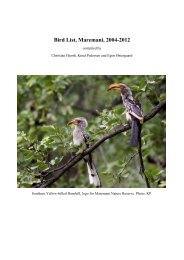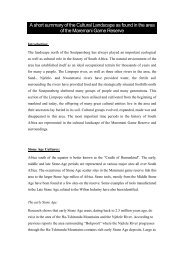the vegetation types and veld condition - Maremani Nature Reserve
the vegetation types and veld condition - Maremani Nature Reserve
the vegetation types and veld condition - Maremani Nature Reserve
You also want an ePaper? Increase the reach of your titles
YUMPU automatically turns print PDFs into web optimized ePapers that Google loves.
Dwarf grass (Oropetium capense) 3%<br />
Flaccid finger grass (Digitaria velutina) 3%<br />
Blue-seed grass (Tricholaena monachne), S<strong>and</strong> Quick (Schmidtia pappophoroides) <strong>and</strong> Guinea grass<br />
(Panicum maximum), occur locally. O<strong>the</strong>r grass species with a frequency of less than 3% are listed in<br />
Table 6.<br />
Forb species cover 11% of <strong>the</strong> area <strong>and</strong> include Indigofera bainesii, Blepharis subvolubilis, Barleria<br />
prionitis, Abutilon austro-africanum, Tephrosia villosa <strong>and</strong> Ocimum americanum.<br />
9. Colophospermum mopane - Catophractes alex<strong>and</strong>ri - Vernonia cinarescens low <strong>and</strong> dense<br />
bush<strong>veld</strong><br />
(Mopane - Trumpet thorn - Vernonia low <strong>and</strong> dense bush<strong>veld</strong>)<br />
This community covers approximately 7000 ha (Figure 2) <strong>and</strong> can be found on <strong>the</strong> gabbro plains of<br />
Boschr<strong>and</strong>, Steenbokr<strong>and</strong>jes, Vryheid <strong>and</strong> Bok<strong>veld</strong> in <strong>the</strong> north-west, as well as on <strong>the</strong> basalt, calc-<br />
silcrete <strong>and</strong> gneiss of Woodhall, Skirbeek, Frampton <strong>and</strong> Njeleles Drift in <strong>the</strong> east of <strong>Maremani</strong>. It occurs<br />
on shallow <strong>and</strong> gravelly red to brown s<strong>and</strong>y loam calcareous soils <strong>and</strong> although rocks are absent in<br />
places, up to 30% of <strong>the</strong> area can be covered by rocks. The slopes vary from 0 to 2Ε. Calcrete is common<br />
in <strong>the</strong> soil horizon. Bush densification is clearly visible in this <strong>vegetation</strong> type as a result of an abundance<br />
of watering points <strong>and</strong> overgrazing in <strong>the</strong> past <strong>and</strong> <strong>the</strong> presence of ab<strong>and</strong>oned old fields.<br />
The presence of Stink shepherd’s tree (Boscia foetida), Trumpet thorn (Catophractes alex<strong>and</strong>ri) <strong>and</strong><br />
Mopane pomegranate (Rhigozum zambesiacum) shows <strong>the</strong> relationship between communities 9, 10 <strong>and</strong><br />
11 (species group 17, Table 6).<br />
The diagnostic species are Trumpet thorn (Catophractes alex<strong>and</strong>ri), Gymnosporia pubescens <strong>and</strong><br />
Vernonia cinarescens (species group 13, Table 6).<br />
High trees (>6 m) have an average canopy cover of 1% <strong>and</strong> are characterised by Mopane<br />
(Colophospermum mopane), Tall common corkwood (Commiphora gl<strong>and</strong>ulosa), Slender three-hook thorn<br />
(Acacia senegal var. leiorhachis) <strong>and</strong> Shepherd’s tree (Boscia albitrunca).<br />
Trees (>3 m - 6 m) cover on average 19% of <strong>the</strong> area <strong>and</strong> <strong>the</strong> dominant species are Mopane<br />
(Colophospermum mopane), Low<strong>veld</strong> cluster-leaf (Terminalia prunioides), Common star chestnut<br />
(Sterculia rogersii), White-stem corkwood (Commiphora tenuipetiolata) <strong>and</strong> Velvet corkwood<br />
25




